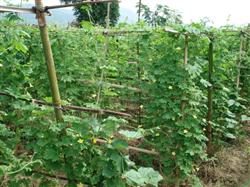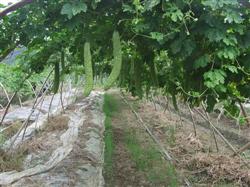Key points of cultivation techniques of Momordica charantia

Momordica charantia is a short-day plant, which likes temperature, light, heat, moisture and shade, and is not strict on the length of light. Long-term light is beneficial to its good growth, but it has high requirements for soil moisture and air humidity, but is not resistant to waterlogging. It can be cultivated in a variety of soils in the south and north of China. In recent years, vegetable farmers in some areas have also grown in greenhouses or greenhouses. The main results are as follows: 1. The selection of good varieties is the key to high yield. Dabai balsam pear and green balsam pear 915 bred by vegetable and Flower Institute of Chinese Academy of Agricultural Sciences are favored by vegetable farmers because of their good quality, high yield, strong disease resistance and so on. Before sowing, the seeds were scalded and stirred in hot water of 55 ℃. When the temperature dropped to 30 ℃, the seeds were soaked for 12 hours (if the seeds were gently clicked open, it would be beneficial for the seeds to absorb water, and the soaking time was 8 hours). Then, wash and fish out the seeds, wrap them with clean gauze and put them in a 30 ℃ incubator to accelerate germination. Rinse with warm water once a day and begin to sprout in about 4-5 days. In this way, it can not only kill the germs carried by the seeds, but also guarantee the budding. 2. Sowing balsam pear in open field, generally raising seedlings in solar greenhouse first. The day before sowing, put the prepared nutritious soil (take pastoral soil that has not been planted with melons) peat: vermiculite: rotten human faeces = 1VR 1vex 0.5 Add diammonium phosphate 1 kg / m3, sift and mix it well, then pile it into a pile, cover it tightly with plastic sheeting, use it after a few days, and need to be evenly mixed again) into a nutrition bowl of 10cm X 10cm, or in a prepared seedling border (the border is squared by 10cm by 10cm with a wooden stick in the middle of the square) and watered thoroughly. After spraying the nutritious soil with water again the next day, sprinkle a thin layer of sifted fine soil and sow. Put the budding seed in the small eye (note: the bud is attached to the soil down), cover the seed with a small mound about 1.5 cm thick, and then spread a layer of fine soil over and over again. Taking the Beijing area as an example, the seeds are usually sown at the end of March and the beginning of April, and the seedling age is about 30-35 days. The cultivation of strong seedlings is one of the factors in the production of pollution-free vegetables. 3. After sowing, the greenhouse should be sealed in order to increase the temperature, a small arch shed should be inserted into the sowing border, and the film should be covered to raise the temperature and moisture, so that the temperature should be protected at 30-35 ℃ in the daytime and above 15 ℃ at night. When 50% of the seedlings emerge, cover the membrane of the small arch shed in time. After the seedlings came out, the indoor temperature was kept at 20-25 ℃ during the day and about 10 ℃ at night. Watering as soon as it is dry, and adopting the principle of temperature control but not water control to keep the seedlings growing healthily. After that, the temperature in the greenhouse was gradually reduced, and the greenhouse film was opened a few days before planting to refine the seedlings. 4. Planting because balsam pear is a temperature-loving and fertilizer-tolerant crop, it is necessary to apply sufficient base fertilizer. Apply 5000 kg of high-quality organic fertilizer and 30 kg of diammonium phosphate every 667m2, and then make a flat border and water it according to 1.5m. After a few days, the soil is slightly loosened, and then a small high border with a width of 80-90cm and a height of 10-15cm is made, and plastic film is covered 5-7 days before planting. Two rows in each row, with a distance of 60 cm, planted with thread. Dig the pit not too deep, it is appropriate to block some water after planting. In order to prevent the ground temperature from falling, the squatting water planting method is generally adopted. after the water in the pit seeps, the pit is sealed and pressed strictly with soil to prevent air leakage. Insert the shelf in time after planting, because the balsam pear is very strong, so insert a firm herringbone frame. The spacing between frames is 20 cm (30 cm for thicker frames). Timely insertion of shelves can also improve the microclimate in the field, which is beneficial to the rapid slowing of seedlings. 1300-1600 plants are planted every 667m2, and the seed amount is 250,300g. 5. slow seedling water should be poured in time after slow seedling management in the field, so the temperature is still low and the water should not be too large. A few days later, deep ploughing was carried out in time to preserve soil moisture and increase soil temperature to promote plant growth and development. Due to the strong branching force of the plant, 2-3 thick vines were selected from the lower part, bound to the shelf, and the rest were wiped out. During this period, it is generally not watered. When the first melon sits down and begins to expand, water and follow the water to pursue 10-15 kg of urea or 20-25 kg of ammonium bicarbonate / 667 m 2. Therefore, when plants enter the peak growth period, they should be watered and fertilized according to weather changes, plant growth and soil conditions. This is called watering to "look at the sky, the earth, and the crops." It should be noted that because the root system of balsam pear is relatively developed and the plant growth potential is strong, watering should not be too frequent, so as not to cause light-growing seedlings without melon, poor ventilation and light transmission will cause diseases or overwhelm the support, resulting in economic losses. Commercial melons were harvested about 40-50 days after planting. There is a large amount of fertilizer and water in the melon-bearing period. 6. Pest control due to strong disease resistance of balsam pear and less diseases, leaf mildew and powdery mildew generally occur in the later growth stage. Generally use 50% methyl topiramate wettable powder 1000 times or 10% trimethoprim EC 1500 times liquid spray. 20% omethoate 1000 times liquid spray to control aphids, propargite 1500-2000 times solution spray to control red spiders and camellia mites.
- Prev

Balsam pear is good for hanging vines early.
In the intercropping of cucumber and balsam pear, vegetable farmers usually crawl on the ground before the failed cucumber seedlings, and hang the balsam pear vines only when the abortive cucumber seedlings are about to pull out the garden. But if you hang the cucumber vine at the same time, but also easily hang up the balsam pear vine will have a lot of benefits. Balsam pear can cultivate strong trees by hanging vines early. In the seedling stage, balsam pear vine.
- Next

It is not advisable for balsam pear to top fertilize with water.
At present, balsam pear vegetable farmers generally use topdressing with water, although this is very convenient, and fertilizer can be evenly applied to the soil, but balsam pear topdressing in this way is not desirable. The reason is that the number of balsam pear plants per mu is less, only 200 plants per mu, only 3 plants per row, if taken with.
Related
- Where is it suitable to grow horseradish in China? it is expected to see the middle altitude horseradish in Alishan.
- How to prevent tomato virus disease reasonably? (Control methods included)
- Many people like to plant towel gourd on the balcony. What are the main points of this method and management?
- What crops can chili peppers be mixed with?
- Fertilization techniques and matters needing attention in Tomato
- What are the grafting techniques for peach seedlings in spring?
- Harm and control methods of root swelling disease of Chinese cabbage
- What are the pests of sweet potatoes? How to prevent and cure it?
- Symptoms, causes and Control methods of navel Rot in Tomato
- The cause of "Cucumber rotten bibcock" in Farmers' planting Cucumber and its Control Plan

